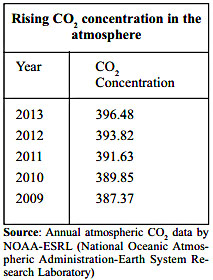|
|
||
|
|
||
|
Carbon dioxide concentrations in atmosphere reach record level For the first time in human history, the average level of carbon dioxide in the atmosphere has exceeded 400 parts per million for an entire month. Indrajit Bose GREENHOUSE gas (GHG) concentrations in the atmosphere are progressively increasing. For the first time in human history, and likely for the first time in at least 800,000 years, the average level of carbon dioxide (CO2) in the Earth's atmosphere has exceeded 400 parts per million (ppm) for an entire month. The average CO2 value for the month of April was 401.33 ppm and each day in April had a reading above 400 ppm, revealed scientists at the Scripps Institution of Oceanography in San Diego, USA. Scripps oversees a Keeling Curve, which is the longest continuous record of CO2 measurements since the late 1950s over the Mauna Loa volcano in Hawaii. The April record is in line with the warnings that the Intergovernmental Panel on Climate Change (IPCC) issued through its working group reports. Unprecedented 'The atmosphere and ocean have warmed, the amounts of snow and ice have diminished, sea level has risen, and the concentrations of greenhouse gases have increased,' said the IPCC's Fifth Assessment Working Group I report. The report also added that warming of the climate system is unequivocal and many of the observed changes are unprecedented over decades to millennia. In fact, the past three decades have been successively warmer. In the Northern Hemisphere, 1983-2012 was the warmest 30-year period in the past 1,400 years (see box).
The IPCC's Working Group III report also warned that in spite of the growing number of mitigation policies worldwide, the annual GHG emissions grew on average 1 Gt CO2eq per year from 2000 to 2010. Without additional mitigation, the world may be headed to a 3.7-4.8řC temperature increase by the end of the century. The worry is the pace at which GHG concentrations are increasing in the atmosphere (see table). Carbon dioxide levels were about 280 ppm before the Industrial Revolution, when humans first began releasing large amounts into the atmosphere. For the past 800,000 years, CO2 levels never exceeded 300 ppm, according to Scripps. The IPCC attributes the rising atmospheric concentrations of CO2 since 1750 to human activity. The Working Group I report states that anthropogenic GHG emissions have increased by 10 Gt CO2eq per year between 2000 and 2011. In 2011 the concentrations of these GHGs were 391 ppm. In a space of three years, this has risen to over 400 ppm. CO2 emissions averaging 400 ppm for a month is new and something that the world needs to worry about. 'Constantly pumping CO2' 'An increase of 0.5 ppm of CO2 indicates an addition of 3.66 Gt of CO2 equivalent to the atmosphere. It is clear that the world is constantly pumping CO2 in the atmosphere,' said PS Swathi, senior principal scientist with the Fourth Paradigm Institute, formerly the Centre for Mathematical Modelling and Computer Simulation, in Bangalore, India. The increase in CO2 emissions is indicative of two important things, says Swathi. 'One, sources of CO2 are increasing, and two, the potency of carbon sinks, which absorb some of the CO2, thereby giving respite to emissions increase, may be decreasing.' NK Indira, another senior principal scientist with the Fourth Paradigm Institute who looks at three such observatories in India, says Indian monitoring stations also show similar results. 'The data from the Indian Astronomical Observatory at Hanle in Ladakh in northern India shows that CO2 concentrations ranged between 396 ppm and 399 ppm in 2013. The station at Pondicherry, a Union Territory in southern India, too showed similar concentrations of CO2 in the atmosphere,' said Indira. Data for 2014 is awaited, and is likely to be published soon. It is thus clear that rising concentrations of GHGs have to be contained to avoid catastrophic impacts of climate change, and this is crucial to factor in, in the global climate change negotiations, which are trying to arrive at a global deal on climate change in 2015. Indrajit Bose is a senior researcher on climate change with the Third World Network. *Third World Resurgence No. 285, May 2014, p 21 |
||
|
|
||
